

In Berries, Heather Arndt Anderson uncovers the offbeat stories of how humans came to love these tiny, bewildering fruits. Readers meet the inventor of thornless brambles; learn ancient fables and berry-lore; discover berries’ uses in both poisonous witches’ brews and modern superfood health crazes. Featuring a selection of historic and original recipes for berry lovers to try, this is a witty and lushly illustrated ramble through the curious history of our favorite fruits, from interlopers like strawberries (not true berries) to the real deal: tomatoes.
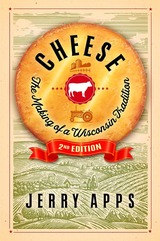
In this updated edition of a classic, Apps examines tumultuous changes in the business over the past twenty years, including the impacts of corporate megafarms and the rise of artisanal producers. Vivid historical photographs and striking portraits of modern family-operated factories reveal the delicate balance between art and science that goes into the process of turning ordinary milk into a wide variety of flavors, from the ubiquitous cheddar to sublime delicacies. Through these stories, we can come to better appreciate the remarkable farmers and producers that shaped cheesemaking into the thriving industry it is today.

This is the first culinary history of a truly remarkable fish. Elisabeth Townsend follows cod around the globe, showing how its pursuit began with the Vikings, and exploring its influence on human affairs ever since. The book looks at the different ways cod has been caught, cooked, and eaten, often by the descendants of explorers, enslaved people, and traders. Cod examines the fish in the myths and legends of the North Atlantic, the West Indies, South America, West and Southeast Africa, and across the Indian Ocean to the Far East. It is a fascinating journey through cod fact and lore and features delectable historical and contemporary recipes that showcase the myriad ways cod can be consumed.
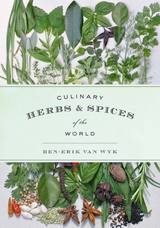

In Dates, Nawal Nasrallah draws on her experience of growing up in the lands of ancient Mesopotamia, where the date palm was first cultivated, to explore the history behind the fruit. Dates have an important role in their arid homeland of the Middle East, where they are a dietary staple and can be consumed fresh or dried, as a snack or a dessert, and are even thought to have aphrodisiac qualities.
In this history, Nasrallah describes the central role the date palm has played in the economy of the Middle East. This informative account of the date palm’s story follows its journey from its land of origin to the far-flung regions where it is cultivated today. Along the way, Nasrallah weaves many fascinating and humorous anecdotes that explore the etymology, history, culture, religion, myths, and legends surrounding dates. For example, she explains how the tree came to be a symbol of the Tree of Life and associated with the fiery phoenix bird, the famous ancient goddess Ishtar, and the moon, and how the medjool date acquired its name.
This delightful and unusual book is generously illustrated with many beautiful images, and supplemented with more than a dozen delicious date recipes for savory dishes, sweets, and wine.
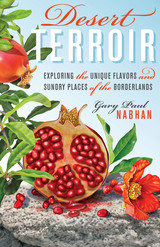
Why does food taste better when you know where it comes from? Because history—ecological, cultural, even personal—flavors every bite we eat. Whether it’s the volatile chemical compounds that a plant absorbs from the soil or the stories and memories of places that are evoked by taste, layers of flavor await those willing to delve into the roots of real food. In this landmark book, Gary Paul Nabhan takes us on a personal trip into the southwestern borderlands to discover the terroir—the “taste of the place”—that makes this desert so delicious.
To savor the terroir of the borderlands, Nabhan presents a cornucopia of local foods—Mexican oregano, mesquite-flour tortillas, grass-fed beef, the popular Mexican dessert capirotada, and corvina (croaker or drum fish) among them—as well as food experiences that range from the foraging of Cabeza de Vaca and his shipwrecked companions to a modern-day camping expedition on the Rio Grande. Nabhan explores everything from the biochemical agents that create taste in these foods to their history and dispersion around the world. Through his field adventures and humorous stories, we learn why Mexican oregano is most potent when gathered at the most arid margins of its range—and why foods found in the remote regions of the borderlands have surprising connections to foods found by his ancestors in the deserts of the Mediterranean and the Middle East. By the end of his movable feast, Nabhan convinces us that the roots of this fascinating terroir must be anchored in our imaginations as well as in our shifting soils.
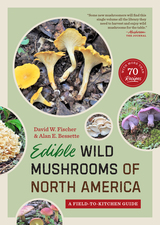
Unusual shapes and colors make many mushrooms alluring to the eye, while the exotic flavors and textures of edible mushrooms are a gourmet delicacy for the palate. Yet many people never venture beyond the supermarket offerings, fearing that all other mushrooms are poisonous.
With amateur mushroom hunters especially in mind, David Fischer and Alan Bessette have prepared Edible Wild Mushrooms of North America. This field guide presents more than 100 species of the most delicious mushrooms, along with detailed information on how to find, gather, store, and prepare them for the table. More than 70 savory recipes, ranging from soups and salads to casseroles, canapes, quiches, and even a dessert, are included.
Throughout, the authors constantly emphasize the need for correct identification of species for safe eating. Each species is described in detailed, nontechnical language, accompanied by a list of key identifying characteristics that reliably rule out all but the target species. Superb color photographs also aid in identification. Poisonous "lookalikes" are described and illustrated, and the authors also assess the risks of allergic or idiosyncratic reactions to edible species and the possibilities of chemical or bacterial contamination.
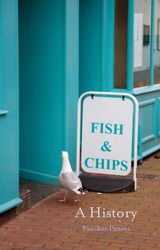
Double-decker buses, bowler hats, and cricket may be synonymous with British culture, but when it comes to their cuisine, nothing comes to mind faster than fish and chips. Sprinkled with salt and vinegar and often accompanied by mushy peas, fish and chips were the original British fast food. In this innovative book, Panikos Panayi unwraps the history of Britain’s most popular takeout, relating a story that brings up complicated issues of class, identity, and development.
Investigating the origins of eating fish and potatoes in Britain, Panayi describes the birth of the meal itself, telling how fried fish was first introduced and sold by immigrant Jews before it spread to the British working classes in the early nineteenth century. He then moves on to the technological and economic advances that led to its mass consumption and explores the height of fish and chips’ popularity in the first half of the twentieth century and how it has remained a favorite today, despite the arrival of new contenders for the title of Britain’s national dish. Revealing its wider ethnic affiliations within the country, he examines how migrant communities such as Italians came to dominate the fish and chip trade in the twentieth century.
Brimming with facts, anecdotes, and images of historical and modern examples of this batter-dipped meal, Fish and Chips will appeal to all foodies who love this quintessentially British dish.

Fixin' Fish was first published in 1984. Minnesota Archive Editions uses digital technology to make long-unavailable books once again accessible, and are published unaltered from the original University of Minnesota Press editions.
Whether you catch it yourself or buy it, fish can be a delicious, nutritious meal or an experience you'd rather forget. Because fish are delicate and perishable, preserving their fresh-caught flavor requires careful handling. Fixin' Fish provides anglers and fish buyers with helpful techniques, not covered in most cookbooks, for handling, cleaning, preserving, preparing, and buying fish of all kinds. Topics covered include: maintaining the quality of fresh fish, building a smokehouse, smoking, canning, pickling, making fish jerky and caviar, and checking fish for parasites. Sport fishermen will find the section on field dressing and packing especially useful.
Minnesota and neighboring states have an abundance of fish that are usually overlooked as a food source. These underutilized fish, which include suckers, eelpout (burbot), carp, bullheads, herring, and freshwater drum, can be delicious if handled and prepared properly. The special techniques described in this book will help anyone make good use of this inexpensive and tasty source of protein.
Fixin' Fish is published by the University of Minnesota Sea Grant Extension Program. This new edition updates the text and adds information on parasites that can be found on freshwater fish in the Minnesota region.


A lighthearted manifesto for the new age of aspics, The Great Gelatin Revival rattles our very understanding of what food can be.

Indulge your senses with the lively flavors, vivid colors, and tantalizing aromas of fresh herbs. This comprehensive guide gives you creative, festive recipes as well as valuable gardening information. With Lucinda Hutson's expert advice you'll discover how to:
- Grow robust and flavorful herbs using organic gardening techniques.
- Harvest and store herbs.
- Prepare more than 150 delicious and innovative recipes.
- Create intensely flavored herb butters and savory vinegars.
- Garnish and flavor recipes with beautiful edible flowers.
- Grow and use exotic herbs from Mexico and Southeast Asia.
- Design menus for special occasions such as a fiesta for friends or a feast for two.
- Find the best sources, including websites, for buying plants, seeds, and gourmet products.
Savor the Tuscan-inspired Panzanella, the continental Celebratory Niçoise Salad, or the Southwestern-spirited Pollo Picado. Lucinda's suggested recipe variations will turn you into a kitchen quick-change artist. Ideas for dazzling presentations make your meals as pleasing to the eye as they are to the palate. From rosemary and thyme to Mexican mint marigold and Thai basil, this is an essential guide for cooks and gardeners alike!
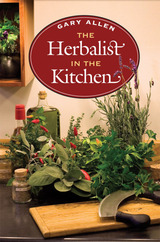
The foodie's ultimate herbal encyclopedia
Created as the ideal reference for anyone with a serious interest in cooking with herbs, spices, or related plant materials, The Herbalist in the Kitchen is truly encyclopedic in scope. It provides complete information about the uses, botany, toxicity, and flavor chemistry of herbs, as well as a listing for nearly every name that an ingredient is known by around the world.
Even including herbs and spices not yet seen in the United States (but likely to be featured in recipes for adventurous cooks soon), The Herbalist in the Kitchen is organized into one hundred and four sections, each consisting of a single botanical family. The book provides all available information about the chemical compounds responsible for a plant's characteristic taste and scent, which allows cooks to consider new subtleties and potential alternatives. For instance, the primary flavoring ingredient of cloves is eugenol; when a cook knows that bay leaves also contain eugenol, a range of exciting substitutions becomes clear. The Herbalist in the Kitchen also provides guidance about measuring herbs, enabling readers to understand the dated measuring standards from antique cookbooks.
A volume in The Food Series, edited by Andrew W. Smith

Salsa and guacamole wouldn’t be the same without cilantro, and you can’t make pizza without oregano or a mojito without mint. You can use peppermint to settle an upset stomach, ease arthritis pain with stinging nettle, and heal burns and wounds with aloe vera. And then there is cannabis—perhaps the most notorious and divisive herb of all. Despite the fact that herbs are often little more than weeds, cultures around the globe have found hundreds of uses for them, employing them in everything from ancient medicines to savory dishes. While much has been written on cooking and healing with herbs, little has been told about the history of the plants themselves and the incredible journeys they have made.
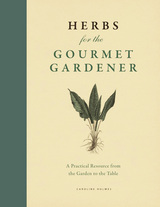
A feast for the eyes and the table, this user-friendly resource traverses the realms of both the garden and the kitchen, addressing the cultivation, storage, and preparation of more than sixty herbs. Practical growing tips, fascinating histories, nutritional information, and classic recipes appear alongside botanical illustrations drawn from the Royal Horticultural Society’s cherished collection. With both familiar varieties and novel options, Herbs for the Gourmet Gardener will inspire you to create a world of new shapes, colors, and tastes.
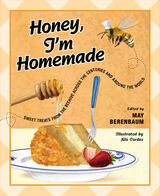
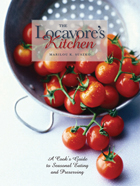
More and more Americans are becoming dedicated locavores, people who prefer to eat locally grown or produced foods and who enjoy the distinctive flavors only a local harvest can deliver. The Locavore’s Kitchen invites readers to savor homegrown foods that come from the garden, the farm stand down the road, or local farmers’ markets through cooking and preserving the freshest ingredients.
In more than 150 recipes that highlight seasonal flavors, Marilou K. Suszko inspires cooks to keep local flavors in the kitchen year round. From asparagus in the spring to pumpkins in the fall, Suszko helps readers learn what to look for when buying seasonal homegrown or locally grown foods as well as how to store fresh foods, and which cooking methods bring out fresh flavors and colors. Suszko shares tips and techniques for extending seasonal flavors with detailed instructions on canning, freezing, and dehydrating and which methods work best for preserving texture and flavor.
The Locavore’s Kitchen is an invaluable reference for discovering the delicious world of fresh, local, and seasonal foods.
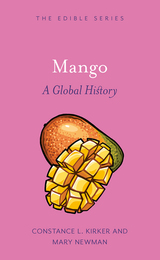
This beautifully illustrated book takes us on a tour through the rich world of mangoes, which inspire fervent devotion across the world. In South Asia, mangoes boast a history steeped in Hindu and Buddhist mythology, even earning a mention in the Kama Sutra. Beyond myth, the authors show us that mangoes hold literary significance as a potent metaphor. While mango-flavored smoothies grace Western grocery shelves, the true essence of sweet, juicy mangoes or tangy, unripe varieties is a rarity: supermarket offerings often prioritize shelf-life over taste.
This book offers an accessible introduction to the world of true mango aficionados and the thousand varieties they cherish.
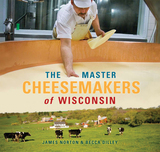
Certification as a Master Cheesemaker typically takes almost fifteen years. An applicant must hold a cheesemaking license for at least ten years, create one or two chosen varieties of cheese for at least five years, take more than two years of university courses, consent to constant testing of their cheese and evaluation of their plant, and pass grueling oral and written exams to be awarded the prestigious title.
James Norton and Becca Dilley interviewed these dairy artisans, listened to their stories, tasted their cheeses, and explored the plants where they work. They offer here profiles of forty-three active Master Cheesemakers of Wisconsin, as well as a glossary of cheesemaking terms, suggestions of operations that welcome visitors for tours, tasting notes and suggested food pairings, and tasty nuggets (shall we say curds?) of information on everything to do with cheese.
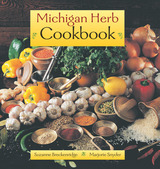
If you're interested in cooking with herbs and want to use the best of Michigan and the Midwest's seasonal foods, then this is the cookbook for you.
The recipe section is written for both the novice and the more experienced cook. Each recipe has helpful information about serving suggestions and menu ideas. Scattered throughout the book are handy tips related to foods, herbs, and cooking. In addition, Michigan Herb Cookbook includes a section on herb growing and designing in which planting, growing, freezing, drying, and storage tips for over thirty herbs are explained in detail.
You will find over 150 recipes in the book's seven chapters. More than half are low-fat, and there are many vegetarian favorites. Also, a chapter devoted to condiments and "little extras" contains various herb blend, vinegar, chutney, pesto, and sauce recipes, such as Sun-Dried-Tomato Pesto and Roasted Red Pepper Sage Sauce.
Suzanne Breckenridge, formerly a ceramics and cooking instructor, is now a food stylist and caterer. Marjorie Snyder is a freelance food writer, a cooking teacher at a junior college, and cofounder and president of the Madison Wisconsin Herb Society.
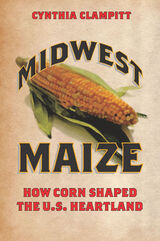

Tender, plump, and tasty, the blue mussel (Mytiius edulis) is treasured in most of the world's cuisines but strangely ignored in North American cooking. This edible mollusk is naturally abundant on both American coasts and easily cultivated. As over-harvesting makes many other seafoods ever more scarce and expensive, the blue mussel offers an inexpensive and attractive alternative to more costly and wasteful sources of protein. To tempt American palates and draw attention to this remarkably versatile and nutritious seafood, Sarah Hurlburt has written The Mussel Cookbook.
In her entertaining introduction, Hurlburt tells about mussels—how they live, how they saved a bridge from collapsing, why barrels of them appeared in American police stations, how they are farmed in Spain, France, and Holland. Then she offers over a hundred recipes. Whether you are a beginning cook or a devotee of haute cuisine, you will find recipes to match your abilities: simple dishes for the out-of-doors, appetizers, soups and stews, salads, casseroles, main dishes from abroad, and elegant party entrees. From Europe Hurlburt brings back paella, cannelloni, and souffle of mussels, among many others. From Asia come curried and stir-fried mussels as well as the delectable midia dolma. There are a dozen quick-and-easy tricks; there are flamed mussels and mussels Rockefeller. She describes how to clean and freeze mussels, and gives tips on how to use them.
Sarah Hurlburt in collaboration with her husband, Graham, has spent many years learning about the blue mussel. Together they have studied European methods of mussel farming and begun their own experimental Cultivation project in Massachusetts. Ms. Hurlburt's recipes have been featured in the New York Times, the Boston Globe, the Boston Herald American, and Harvard Magazine. Stories about the Hurlburts' adventures with mussels have appeared in the Washington Post, the Cornell Quarterly, and the Marine Fisheries Review. A discussion of their work has appeared in the Congressional Record.

In this delightful global history of all things Grey Poupon and gleaming yellow, Demet Güzey takes readers on a tour of the ubiquitous mustard, exploring its origins, its use in medicine and in the kitchen, its place in literature, language, and religion, and its strong symbolism of sharpness, perseverance, and strength. Packed with entertaining mustard facts and illustrations as well as a selection of historic and modern recipes, this surprising history of one of the world’s most loved condiments will appeal to all food history aficionados.
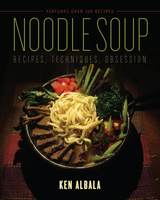
This primer offers the recipes and techniques for mastering quick-slurper staples and luxurious from-scratch feasts. Albala made a different noodle soup every day for two years. His obsession yielded all you need to know about making stock bases, using dried or fresh noodles, and choosing from a huge variety of garnishes, flavorings, and accompaniments. He lays out innovative techniques for mixing and matching bases and noodles with grains, vegetables, and other ingredients drawn from an international array of cuisines. In addition to recipes both cutting edge and classic, Albala describes new soup discoveries he created along the way. There's advice on utensils, cooking tools, and the oft-overlooked necessity of matching a soup to the proper bowl. Finally, he sprinkles in charming historical details that cover everything from ancient Chinese millet noodles to that off-brand Malaysian ramen at the back of the ethnic grocery store.
Filled with more than seventy color photos and dozens of recipes, Noodle Soup is an indispensable guide for cooking, eating, and loving a universal favorite.

Tracking these fruits and seeds through cultivation, harvesting, processing, and consumption—or non-consumption, in the case of those with nut allergies—award-winning food writer Ken Albala provides a fascinating account on how they have been cooked, prepared, and exploited. He reveals the social and cultural meaning of nuts during various periods in history, while also immersing us in their modern uses. Packing scrumptious recipes, surprising facts, and fascinating nuggets inside its hardcover shell, this entertaining and informative book will delight lovers of almonds, hazelnuts, chestnuts, and more.
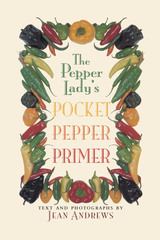
More than a quarter of the people on earth eat peppers every day of their lives, and true pepper lovers are always looking for better-tasting, hotter peppers. This handy, reliable guide makes finding them easy, as capsicum expert Jean Andrews shows you how to identify and use 42 peppers, both fresh and dried, commonly available in North American markets.
Andrews describes each pepper in detail, starting with its size, color, fruit shape, flesh, and pungency. She gives its common names, sources, and uses, and indicates other peppers that can substitute for it in recipes. Drawing on her vast store of pepper lore, she also includes notes and anecdotes about each pepper. Her color photographs illustrate all of the peppers.
In addition to the species descriptions, Andrews offers practical guidance on selecting and storing, roasting and rehydrating, and growing and harvesting peppers. She explains pepper nomenclature, describes the pungency factor, and notes the significance of color, aroma, flavor, and nutrition.
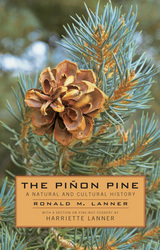
An engaging look at the history of the piñon pine and its ecosystem. Combining natural history and observations of the cultural importance of the tree to both native Indians and European settlers, Lanner provides information on the management of the tree and its interdependence with the birds and animals of the piñon-juniper woodland. Science, cultural history, and ecologicall issues, plus delicious recipes using the piñon pine nuts, make for a concise natural and cultural history of the piñon pine.

Stone takes us back to the early polytheistic religions and the important role that pomegranates had in their rituals. From there he shows how they came to be held in high esteem in Judaism, Christianity, and Islam alike, examining exciting new findings that further cement their importance: for instance, many historians believe now that it was a pomegranate, not an apple, that was the forbidden fruit in the Garden of Eden. Stone examines the allure that the pomegranate has had to a fascinating cast of famous figures, from ancient Assyrian King Ashurnasirpal to Tudor Queen Anne Boleyn, from Sandro Botticelli to Salvador Dalí. Drawing on text, image, and taste, Pomegranate is a cornucopia of strange and fascinating stories about a very special fruit.
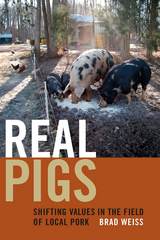
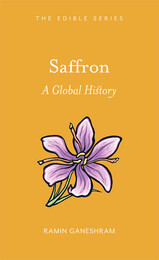
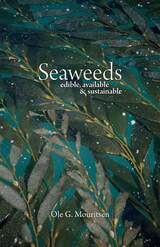

The scent of oregano immediately conjures the comforts of Italian food, curry is synonymous with Indian flavor, and the fire of chili peppers ignites the cuisine of Latin America. Spices are often the overlooked essentials that define our greatest eating experiences. In this global history of spices, Fred Czarra tracks the path of these fundamental ingredients from the trade routes of the ancient world to the McCormick’s brand’s contemporary domination of the global spice market.
Focusing on the five premier spices—black pepper, cinnamon, nutmeg, cloves, and chili pepper—while also relating the story of many others along the way, Czarra describes how spices have been used in cooking throughout history and how their spread has influenced regional cuisines around the world. Chili peppers, for example, migrated west from the Americas with European sailors and spread rapidly in the Philippines and then to India and the rest of Asia, where the spice quickly became essential to local cuisines. The chili pepper also traveled west from India to Hungary, where it eventually became the national spice—paprika.
Mixing a wide range of spice fact with fascinating spice fable—such as giant birds building nests of cinnamon—Czarra details how the spice trade opened up the first age of globalization, prompting a cross-cultural exchange of culinary technique and tradition. This savory spice history will enliven any dinner table conversation—and give that meal an unforgettable dash of something extra.
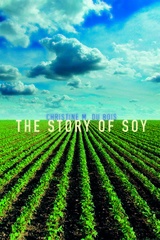
Traveling across the globe and through millennia, The Story of Soy includes a cast of fascinating characters as vast as the soy fields themselves—entities who’ve applauded, experimented with, or despised soy. From Neolithic villagers to Buddhist missionaries, European colonialists, Japanese soldiers, and Nazi strategists; from George Washington Carver to Henry Ford, Monsanto, and Greenpeace; from landless peasants to petroleum refiners, Du Bois explores soy subjects as diverse as its impact on international conflicts, its role in large-scale meat production and disaster relief, its troubling ecological impacts, and the nutritional controversies swirling around soy today. She also describes its genetic modification, the scandals and pirates involved in the international trade in soybeans, and the potential of soy as an intriguing renewable fuel. Featuring compelling historical and contemporary photographs, The Story of Soy is a potent reminder never to underestimate the importance of even the most unprepossesing sprout.

From marzipan pigs and nutty nougat to bubblegum and bonbons, Sweets and Candy looks beneath the glamour and sparkle to explore the sticky history of confectionary. Methods for making sweets can be traced back to the importance of sugar in Arabic medicine and the probable origin of this practice in ancient India—a place where sweetness is still important for both humans and gods. Gorging on gobstoppers from these early candy antecedents to modern-day delectables, Laura Mason describes the bewildering and fascinating ways in which different cultures have made, consumed, valued, and adored sweets throughout history. Featuring a selection of mouthwatering illustrations and scrumptious recipes to try at home, this global candy trail will delight sweet-toothed foodies and history buffs everywhere.
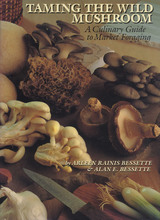
Many mushroom hunters prefer to do their foraging in the marketplace, where all the mushrooms are clearly labeled and safely edible. With this fact in mind, Arleen and Alan Bessette have written Taming the Wild Mushroom, one of the first cooking guides devoted exclusively to choosing and preparing the mushroom species now available in many grocery stores, supermarkets, and natural and whole foods markets.
A dozen wild and cultivated species are covered in the book, including White Button, King Bolete, Oyster, Chanterelle, Morel, Paddy Straw, Wood Ear, Shiitake, Enokitake, White Matsutake, Black Truffle, and Wine-cap Stropharia. Easy-to-understand descriptions and excellent color photographs of each species help market foragers choose mushrooms in peak condition. Fifty-seven original, species-specific recipes, from appetizers, soups, and salads to meat and vegetarian entrees to sauces and accompaniments, offer dozens of ways to savor the familiar and exotic flavors of these mushrooms. A mouth-watering photograph accompanies each recipe.

The abundance of seafood available from the northwest Gulf of Mexico includes hundreds of delicious species that are often overlooked by consumers. Celebrating this regional bounty, Texas Seafood showcases the expertise of longtime fishmongers and chefs PJ and "Apple Srimart" Stoops. Readers will find familiar fish like Red Snapper along with dozens of little-known finfish and invertebrates, including tunas, mackerels, rays, and skates, as well as bivalves, shrimps, crabs, and other varieties, many of which are considered “bycatch” (seafood that a fisher didn’t intend to catch), but that are no more difficult to prepare and just as delicious as those commonly found at your local supermarket.
The Stoopses provide a complete primer on sourcing these wild-caught delicacies, with fascinating details about habitats and life cycles as well as practical advice on how to discern quality. Texas Seafood concludes with simple, delectable recipes, many infused with the flavors of Apple’s Thai heritage. Dishes such as Steamed Curried Crab, Crispy White Shrimp, Escolar on a Grill with Green Mango Salad, Cast-Iron-Roasted Shortfin Mako Shark with Rio Grande Grapefruit, and Chicken-Fried Ribbonfish are just a few ways to savor the best of the Gulf.

To the untrained eye, there’s nothing as unexciting as tofu, normally regarded as a tasteless, beige, congealed mass of crushed, boiled soybeans. However, tofu more than stands up on its own. Reviled for decades as a vegetarian oddity, the brave, wobbly block has made a comeback. This global history of bean curd stretches from ancient creation myths and tomb paintings, via Chinese poetry and Japanese Buddhist cuisine, to deportations in Soviet Russia and struggles for power on the African continent. It describes the potentially non-Chinese roots of tofu, its myriad types, why “eating tofu” is an insult in Cantonese, and its environmental impact today.
Warning: this book actually makes tofu exciting. It’s anything but bland.
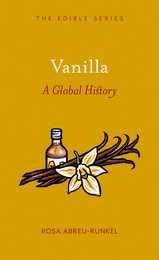
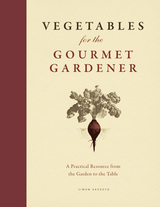
A feast for the eyes and the table, this user-friendly resource traverses the realms of both the garden and the kitchen, addressing the cultivation, storage, and preparation of nearly seventy useful vegetables. Practical growing tips, fascinating histories, nutritional information, and classic recipes appear alongside botanical illustrations drawn from the Royal Horticultural Society’s cherished collection. With both familiar varieties and novel options, Vegetables for the Gourmet Gardener will inspire you to create a world of new shapes, colors, and tastes.
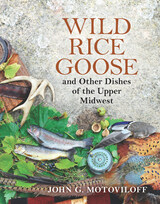
Wild Rice Goose also revives overlooked dishes popular in times past. If you have carp, redhorse, smelt, or turtle, dandelion greens or mulberries, you can turn these humble finds into tasty treats with tips from experienced fishermen and foragers. Cooks will appreciate the clear, kitchen-tested recipes, and fans of sporting literature will enjoy the lyrical writing.
You’ll find here:
• more than 100 recipes for wildfoods from asparagus to venison
• sidebars on regional foods, specialty preparations, and folk history
• tips on finding and cleaning game, fish, and wild edibles
• advice on freezing and drying
• a list of Upper Midwest wildfoods vendors.
Best Regional Special Interest Books, selected by the American Association of School Librarians
Best Regional General Interest Books, selected by the Public Library Reviewers
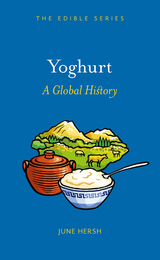
READERS
Browse our collection.
PUBLISHERS
See BiblioVault's publisher services.
STUDENT SERVICES
Files for college accessibility offices.
UChicago Accessibility Resources
home | accessibility | search | about | contact us
BiblioVault ® 2001 - 2024
The University of Chicago Press









